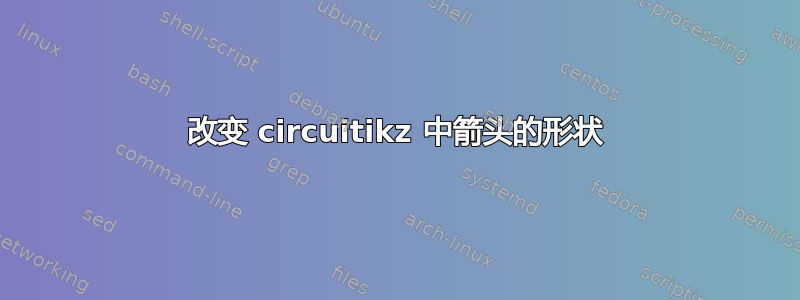
事实上,在下面的代码中,你可以看到 omega{\phi} 下的箭头与电压的箭头不同。我希望有与电压类似的箭头。
\documentclass[review]{elsarticle}
\usepackage{graphicx}
\usepackage{amssymb,amsmath,nccmath}
\usepackage{cclicenses}
\usepackage{makecell}
\usepackage[straightvoltages]{circuitikz}
\usetikzlibrary{arrows}
\usepackage{lscape,array}
\begin{document}
\begin{circuitikz}[scale=0.5][american voltages]
\ctikzset{bipoles/length=.8cm}
\draw
(0,0) to [open,v>=$v_{ds}$] (0,5)
to [short, *- ,i=$i_{ds}$] (0.3,5)
to [R, l=$R_s$] (2,5)
to [L, l=$X_s$] (3.2,5)
to [european voltage source, l^=$\omega_s \phi_{qs}$] (4.9,5)
(4.5,5) to [short, -] (5,5)
(5,5) to [L, l_=$X_m$] (5,0)
(5,5) to [european voltage source, l^=$\omega_r \phi_{qr}$] (7,5)
to [L, l=$X_r$] (8,5)
to [R, l=$R_r$] (10,5)
to [short, -* ,i<=$i_{dr}$] (10.3,5)
(10.3,0) to [open, v>=$v_{dr}$] (10.3,5)
(0,0) to [short, *-*] (10.3,0);
\draw[->](3.5,4.3) -- (4.9,4.3);
\draw[->](6.5,4.3) -- (5.1,4.3);
\end{circuitikz}
\end{document}
答案1
包装arrows.meta提供许多不同的箭头
尝试
\draw[-Triangle] (3.5,4.3) -- (4.9,4.3);
\draw[-Triangle] (6.5,4.3) -- (5.1,4.3);
并替换\usetikzlibrary{arrows}为\usetikzlibrary{arrows.meta}。
完整的文件考虑到我的答案:
\documentclass{article}
\usepackage{tikz}
\usepackage[straightvoltages, european]{circuitikz}
\usetikzlibrary{arrows.meta}
\begin{document}
\begin{circuitikz}[ scale=0.5, % i would rather scale 0.6, if possible
font=\footnotesize % <-- smaller font
]
\ctikzset{bipoles/length=7mm} % <-- smaller bipole elements
%
\draw (0,0) to [open,v>=$v_{ds}$] (0,4)
to [short, *- ,i=$i_{ds}$] (0.5,4)
to [R, l=$R_s$] (2,4)
to [L, l=$X_s$] (3.5,4)
to [V, l^=$\omega_s \phi_{qs}$] (5,4)
(5,4) to [short] (5.5,4)
(5.25,4)to [L, l_=$X_m$, *-*] (5.25,0)
(5.5,4) to [V, l^=$\omega_r \phi_{qr}$] (7,4)
to [L, l=$X_r$] (8.5,4)
to [R, l=$R_r$] (10,4)
to [short, -* ,i<=$i_{dr}$] (10.5,4)
to [open, v^<=$v_{dr}$] (10.5,0)
(0,0) to [short, *-*] (10.5,0);
\draw[-Triangle] (3.5,3.3) -- + ( 1.5,0);
\draw[-Triangle] (7.0,3.3) -- + (-1.5,0);
\end{circuitikz}
\end{document}
笔记。 混合美式和欧式的电气/电子电路绘制风格被认为是不好的做法。
答案2
像这样吗?
\usepackage[straightvoltages]{circuitikz}
\usetikzlibrary{arrows}
\usepackage{lscape,array}
\begin{document}
\begin{circuitikz}[scale=0.5][american voltages]
\ctikzset{bipoles/length=.8cm}
\draw
(0,0) to [open,v>=$v_{ds}$] (0,5)
to [short, *- ,i=$i_{ds}$] (0.3,5)
to [R, l=$R_s$] (2,5)
to [L, l=$X_s$] (3.2,5)
to [european voltage source, l^=$\omega_s \phi_{qs}$] (4.9,5)
(4.5,5) to [short, -] (5,5)
(5,5) to [L, l_=$X_m$] (5,0)
(5,5) to [european voltage source, l^=$\omega_r \phi_{qr}$] (7,5)
to [L, l=$X_r$] (8,5)
to [R, l=$R_r$] (10,5)
to [short, -* ,i<=$i_{dr}$] (10.3,5)
(10.3,0) to [open, v>=$v_{dr}$] (10.3,5)
(0,0) to [short, *-*] (10.3,0);
\draw[-latex](3.5,4.3) -- (4.9,4.3);
\draw[-latex](6.5,4.3) -- (5.1,4.3);
\end{circuitikz}
\end{document}
在我看来,这些箭头就像latexTi 提供的标准箭头钾Z.如果您希望所有箭头都像这样,只需\tikzet{>=latex}在文档开头的某处使用即可。




